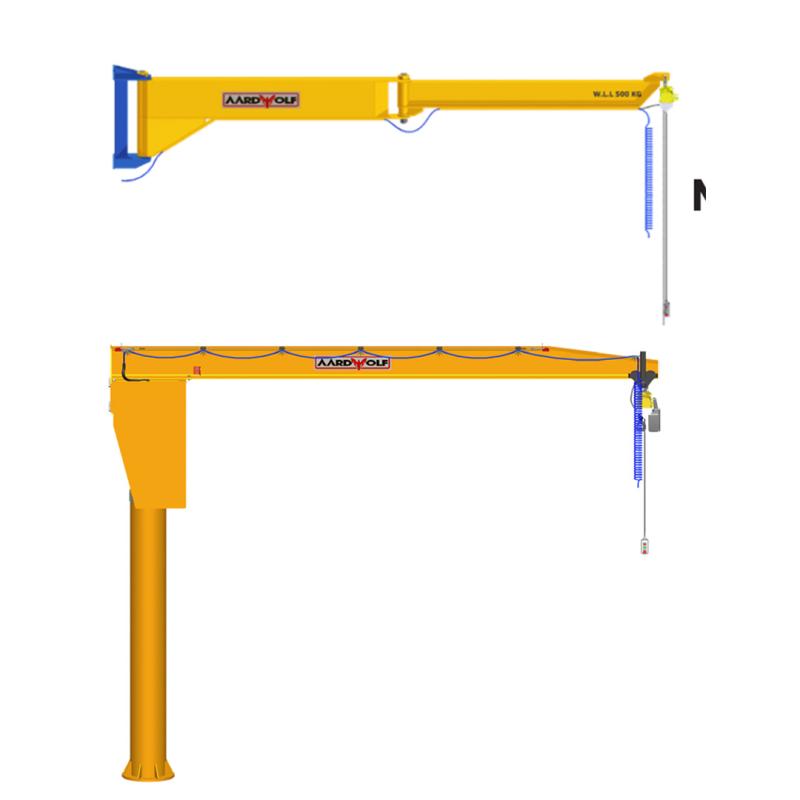



Among the various types available, two of the most commonly compared models are the pillar mounted jib crane and the wall mounted jib crane. While both serve the same fundamental purpose—localized lifting support—they differ significantly in design, installation requirements, and operational flexibility.
If you're in the process of selecting a jib crane for your facility, this guide will help you compare pillar mounted and wall mounted jib cranes in terms of features, applications, and suitability for specific environments.
To view the full spectrum of available crane types, browse Aardwolf's range of Types of Jib Cranes.
Jib cranes are versatile lifting devices that consist of a horizontal boom (jib) which supports a lifting mechanism such as a hoist or vacuum lifter. The jib is attached either to a wall, pillar, or floor-mounted column and is designed to rotate, enabling the crane to move loads across a designated circular or semi-circular work area.
Jib cranes are categorized based on how they are mounted—commonly into wall-mounted, pillar-mounted (also called column-mounted), freestanding, ceiling mounted, and articulating types.
For an in-depth look at the structural differences between crane systems, read The difference between crane and jib cranes
A pillar mounted jib crane (also known as a column-mounted jib crane) is a self-supporting system that is bolted directly to a concrete foundation. This type offers 360-degree continuous rotation and is typically used for medium to heavy-duty lifting in areas where maximum flexibility and load coverage are required.
A wall mounted jib crane is affixed to an existing structural wall or building column and offers a 180-degree swing arc. This type is best suited for areas where floor space is limited and moderate lifting tasks are performed near walls or production lines.
| Feature | Pillar Mounted Jib Crane | Wall Mounted Jib Crane |
|---|---|---|
| Rotation Range | 360° | 180° |
| Load Capacity | High (up to several tons) | Moderate (typically under 1 ton) |
| Mounting Location | Floor/Concrete Foundation | Building wall or support column |
| Space Usage | Requires floor space | Conserves floor space |
| Installation Complexity | Higher (requires foundation) | Lower (no foundation needed) |
| Structural Independence | Fully independent | Depends on wall strength |
| Cost | Higher upfront investment | More cost-effective |
| Best Suited For | Open zones, heavy lifting | Confined areas, light lifting |
The right jib crane depends on the layout of your facility, the weight of materials handled, and the workflow requirements of your operations.
Want to explore additional options such as ceiling mounted or articulating jib cranes? Read more on The key role of Jib Cranes
Installing a pillar-mounted model requires a properly designed concrete foundation. The base must be capable of withstanding both static and dynamic forces generated during lifting operations. You may need to factor in:
For wall-mounted units, the wall or support column must be capable of absorbing the rotational and vertical load forces. While less complex than pillar installations, it's critical to:
For a full guide, refer to Aardwolf’s step-by-step article on how to Install a jib crane
Still undecided between the two? Consider combining your primary jib crane with other systems like:
Each crane type is engineered for specific applications, and the best performance often comes from integrating multiple systems within your material handling strategy.
Both pillar mounted and wall mounted jib cranes offer unique advantages, and the best choice ultimately depends on your facility’s layout, load requirements, and space availability.
Investing in the right type of jib crane ensures long-term safety, productivity, and workflow efficiency in your material handling operations.
To explore specifications, load capacities, and mounting options, visit Aardwolf’s complete collection of Types of Jib Cranes
References
1. How to operate a Jib Cranes safely
3. Over brace jib crane wall mounted
5. Is a Jib Crane a Gantry Crane
6. Articulated Jib Crane Wall Mounted
8. Manual Counterbalance Crane
10. Over Braced Jib Crane Column Mounted
Sign up to receive the latest info on new Aardwolf products, special offers and more.
By signing up you agree to receive emails from Aardwolf with news, special offers, promotions and other information. You can unsubscribe at any time.